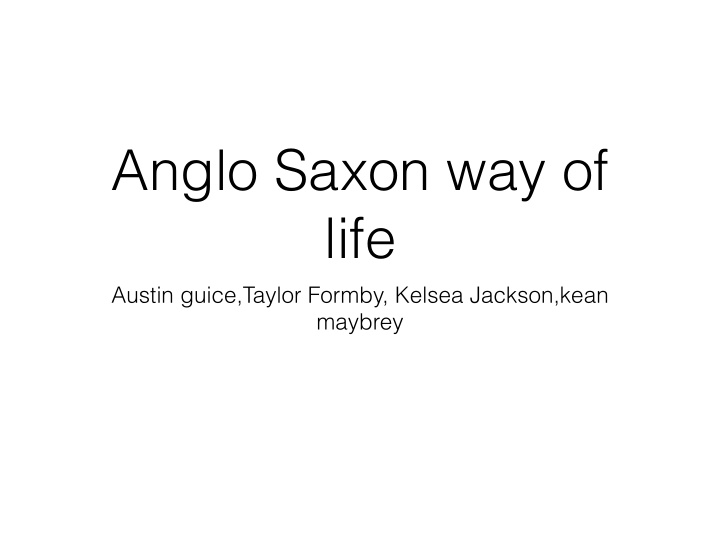



Anglo Saxon way of life Austin guice,Taylor Formby, Kelsea Jackson,kean maybrey
Food • The Anglo Saxon ate many foods we eat today but they had to grow there own foods. They grew wheat, barley,and rye which could be used to make flour. • Deer, boar, and birds was also eaten. They also ate fish, oysters, and mussels. • Everyone drank because the water was polluted. And wine and mead (made of honey) even the kids drunk beer.
Cooking • Nearly all foods were boiled in a cauldron over a fire and eaten as kind of a stew. • They drank ale from drinking horns because the river water was often polluted. • They ate what they grew on their farm land and such. • Cereals: wheat and rye for bread. • Vegetables:carrots,parsnip, cabbage, peas, beans and onions. • Fruit: apples, Cherries, and plums
Farming • Cows/cattle:beef&milk • Sheep: lamb,mutton and ewes milk • Goats:milk and meat • Pigs:meat • Chicken:eggs and meal • Milk was used to make cheese and butter.
House and house • The Saxon mainly built there houses in wood • There houses were huts made of wood with roofs made out of thatched with straws • Britain was mainly woods so they had plenty material to build off of. • The hut was one room were everyone cooked,ate,slept. And also entertained there friends. • They built there huts facing the sun so they could get as much sunlight and heat as possible.
Clothing • Men: • 5th and 6th centuries: they wore an under dress or linin hip-length undershirts with long sleeves. • Woolen trousers were held up with a belt threaded through the loops. • A tunic was pulled over the head and reached down to the knees. It was usually decorated at the wrists, neck and was long sleeved. • The belt buckle was decorated and had a strap end. • Pouches, knives and other accessories were hung from the waist. • Shoes made from a single piece of leather but with an extra piece to form the sole.
Clothing • 7th to 11th centuries: tunics had extra pleats and sleeves became tight- fitting between elbow and wrist. • Bands of cloth were wound around the leg from knee to ankle. • Belts became thinner. • Their shoes were often fastened with buckles or buttons. • Jewelry became very popular. • They had hats of straw,wool and leather. • Most clothes were made at home. • Underclothes were not dyed but outer clothes were dyed or natural color, bleached.
Clothing • Women: • 5th to 7th centuries: they wore underdressed mad of linen or wool with long sleeves and drawstring neck. • For the wealthier women they had clasps made of string or braided. • Their dress was was often called a "peplos". Shoes made of leather. • Jewelry was very popular. • 7th to 9th centuries: the under dress was cut longer than the outer dress. • Veils held on by headbands became popular.
Clothing • 10th and 11th centuries: underdressed was pleated or folded. • The sleeves flared outward. • Dresses were edged with tablet weave and head dresses became larger. • Making the clothes was womens work. • They women sewed in weaving houses or against a wall outside with a wooden loom.
Tradition and customs Angle - seasons liked to sather in the Lords great hall. They liked to listen to music and stories. They loved hearing stories about brave warriors and their adventures. Their favorite story was how Beowulf killed the man eating monster Grendel and his harried mother. They believed in many gods like the Vikings of Scandinavia.
• They were pagan gods. • The king of the Anglo-Saxon gods was Wolden . • They believed in lucky charms. • They thought the charms would protect them from sickness and spirits. • When they died they got buried with their belongings. they thought they would need them in the after life.
Here is there huts that they lived in.
Here is a picture of there village
Beowulf poem
Here is Grendel the man eating monster that the story talks about in slide seven
Recommend
More recommend